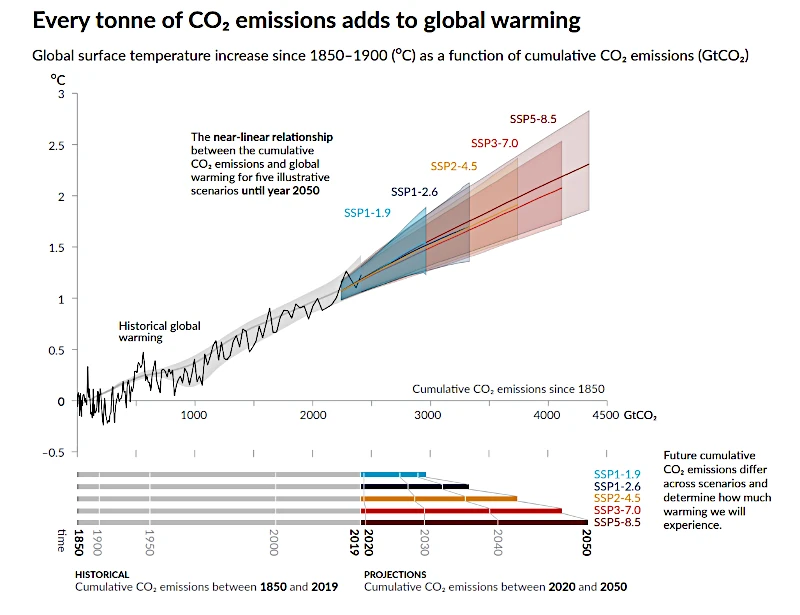
Image description: The differences in global average surface temperature are calculated relative to the period 1850–1900. Regardless of the scenario, it is only after 2030 that the curves really start to diverge. After that, the extent of climate disasters will depend on the scenario, and thus on our behavior. Source: The Physical Science Basis. Working Group I Contribution to the Sixth Assessment Report of the Intergovernmental Panel on Climate Change.
The 6th IPCC Report 2021-2022 reaffirms with high confidence the conclusion of the previous report that there is a nearly linear relationship between anthropogenic CO2 emissions and the global warming they cause.
The IPCC has developed 5 scenarios for 2100 regarding greenhouse gas emissions (CO2, CH4, and N2O).
The differences in global average surface temperature are calculated relative to the period 1850–1900.
Regardless of the scenario, a 2°C global warming would be exceeded during the 21st century.
Since the period 1850–1900, the global average temperature has increased by 1.1°C. Since the 1970s, an amplification has appeared with a rate of 0.15 to 0.20°C per decade.
Depending on the scenarios (from the most optimistic to the most pessimistic), the temperature will have increased by +1.5°C to 1.6°C by 2040, by 1.6°C to 2.4°C between 2041 and 2060, and by 1.4°C to 4.4°C between 2081 and 2100.
The next 20 years will be decisive.
• SSP1-1.9 (very low emissions): +1.5°C compared to 1850–1900 (Paris Agreement). In this scenario, global CO2 emissions fall to zero by around 2050. Societies adopt more environmentally friendly practices, focusing not on economic growth but on general well-being. Investments in education and health increase, and inequalities decrease. Extreme weather events are more frequent, but the world has avoided the worst consequences of climate change.
• SSP1-2.6 (low emissions): +1.8°C compared to 1850–1900 by the end of the century. In this scenario, global CO2 emissions fall to zero after 2050.
• SSP2-4.5 (intermediate emissions): +2.7°C compared to 1850–1900 by the end of the century. In this scenario, CO2 emissions fluctuate around current levels and start to decrease mid-century. No abrupt change in our behaviors.
• SSP3-7.0 (high emissions): +3.6°C compared to 1850–1900 by the end of the century. In this scenario, CO2 emissions are nearly doubled compared to current levels by 2100.
• SSP5-8.5 (very high emissions): +4.4°C compared to 1850–1900 by the end of the century. In this scenario, CO2 emissions are nearly doubled by 2050. The global economy grows rapidly, but this growth is fueled by the exploitation of fossil fuels and very energy-intensive lifestyles.
The increase in global temperature impacts cyclones and their intensity, sea level rise and its intensity, coastal erosion and its intensity, heatwave duration and intensity, etc.
Scenario 1 and Scenario 5 are very unlikely. However, many climate changes due to CO2 emissions (past and future) are irreversible, particularly the changes observed in the oceans and ice caps. But some changes can still be slowed and limited through actions at various levels, from individual to international scales.
• Reducing greenhouse gas emissions: The main sources of emissions are related to the use of fossil fuels (oil, gas, coal), agriculture, and industry. To reduce emissions, it is necessary to decrease our fossil energy consumption, promote renewable energy sources (solar, wind, hydro), reduce emissions from transportation and agriculture.
• Promoting eco-friendly actions: At the individual level, everyone can act against climate change by adopting more sustainable and energy-efficient practices, such as reducing energy consumption, minimizing waste, using public transport, or favoring soft modes of transport.
• Encouraging innovation: Support innovation to develop technologies that emit fewer greenhouse gases and find solutions for energy storage, energy efficiency, renewable energy production, sustainable agriculture, and waste management.
• Encouraging policies and international agreements: It is important to support policies that encourage the reduction of greenhouse gas emissions and the transition to a decarbonized economy. International agreements like the Paris Agreement can also help achieve emission reduction goals.
• Raising awareness and education: To succeed in limiting climate change, it is necessary for everyone to be aware of the issues and solutions to address them. Awareness and education about environmental protection can help change mindsets and behaviors.
These actions may seem ambitious, but they are necessary to avoid putting all our resources into repairing the damage caused by the upcoming climate change.